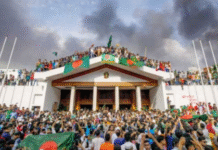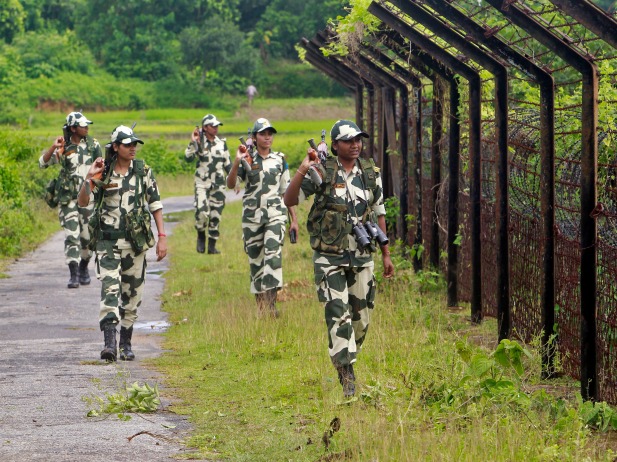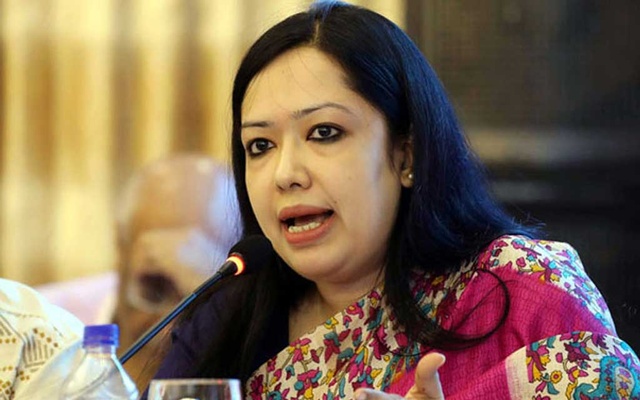TBS

Sanjida Ahmed Tonni became one of the most unforgettable faces of the July Uprising. The image of the Dhaka University student — bloodied and battered, standing with her weary hands raised as a Chhatra League activist attacks her, her eyes filled with horror and helplessness, stirring both heartbreak and outrage across the nation — turned into a symbolic representation overnight.
It was 15 July 2024.
As students of Dhaka University came out of their dormitories, defying obstacles and the fear of Chhatra League, Sanjida joined them at Raju Memorial around 2pm. Soon after, they came to know that some students had been trapped by Chhatra League in halls, and they marched to rescue them.
Throughout July last year, women did not only have a symbolic presence, but also fought alongside the men, and even mothers came out on the streets with their children and joined the protests. We also saw footage of mothers offering water to the agitating students, and fighting back police and Awami League cadres.
However, Chhatra League chased the students near Surjo Sen Hall with locally-made weapons, forcing them towards the VC Chattar. They began beating the female students who had taken cover near two parked buses and started throwing stones.
One such stone struck Sanjida directly in the face — gravely wounding her, shattering the glasses she depended on to see the world. Fresh blood spattered across her face, but the danger was far from over.
“I couldn’t do anything or see an escape route as my glasses shattered, and they were beating us violently just because we dared to protest against them,” Sanjida said.
That was when the iconic picture of her helplessness was taken. The photo immediately went viral online.
It became a defining moment, igniting widespread outrage among Bangladeshis and fuelling protests. What began as a demonstration against the quota system quickly grew into a larger movement against the autocracy and thugocracy of Sheikh Hasina’s regime.
From the beginning of July, female students led the protests, rallies and sit-ins.
Women protesters also faced the movement’s earliest bloodshed, sparking greater outrage and strengthening the resolve of other students to stand firm against the fascist regime.
Throughout July, women were not only in symbolic presence but they fought alongside the men — mothers came out on the streets with their children and joined the protests. We also saw footage of mothers offering water to the agitating students, and fighting back police and Awami League cadres by pelting stones.
More than a dozen women sacrificed their lives in the July Uprising.
Still, a year after the July Uprising, the question that continues to frustrate many is: Where are the women, who sacrificed so much and actively took part in the uprising that led to the ouster of the fascist regime? Where have they disappeared?
Ashrefa Khatun too played a significant role in the July Uprising.
She believes the turning point of the movement came the night her comrades from Ruqayyah Hall came out and protested Sheikh Hasina’s insulting remarks about the agitating students.
“That was the night we chanted slogans like, ‘Bought with the blood of millions of martyrs — this country is not someone’s father’s property,'” Ashrefa recalled.
She believes the silent disappearance of women from the movement’s frontlines has a lot to do with how they are treated on social media.
Her words are backed by countless examples.
After a leader of the National Citizen Party (NCP) was exposed for predatory behaviour towards a female party activist, a prominent YouTube-based ‘journalist’ baselessly attacked the character of another well-known female NCP leader, assuming she was the victim.
Even in his wrong assumption, instead of standing by her, he doubled down on hate — publicly smearing her in front of millions of followers, causing unbearable trauma for the woman in question.
The pattern does not stop there. If you look at the disinformation campaign and character assassination targeting Tasnim Jara — even a newspaper participated in spreading slander under the guise of fact-checking — you will easily understand the underlying reasons.
Ashrefa highlighted another case, perhaps a clear example of patriarchy. “If you look at the reform commissions — except perhaps the Women’s Commission — no female students were included,” she said.
From a perspective of political realism, placing women at the forefront was a strategic move, and the student leaders took full advantage of that during the July Uprising.
However, once Hasina was toppled, that political necessity took a back seat.
While Bangladesh is now undergoing a cascade of reform agendas, including one supposedly for women, the reality tells a different story.
The disconnect between what’s written on paper and the near-total absence of women in the field and decision-making roles raises an uncomfortable question: Does the absence of July girls, who stood for the country, bled, and then disappeared, signal a truly promising, inclusive future?
“Unfortunately, women protesters did not get the stake they deserved in post-Hasina Bangladesh,” said Sanjida Ahmed.
“The way women were prioritised during the movement is no longer the case. If a woman tries to come forward, her personal life becomes more of a target than her politics.”









